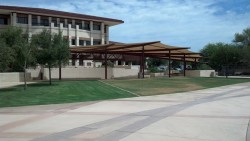Shade cloth is the term used when describing the shade material used for awnings, shade sails, shade structures and sun shades. The strength of shade cloth is measured by the weight of the material. Similar to the thickness of steel or a wood beam, the heavier the weight the stronger the material is.
Most shade cloths offer up to 95% UV blocking capabilities; this value is described differently by each manufacturer but all have the same performance meaning in UVA and UVB blocking capabilities. Shade cloth used at your local green house or nursery is going to be a 50% UV shade cloth and very light weight material (any heavier the plants would not get enough sun). We provide shade so we do not offer any material less than 95% UVA and UVB blocking.
Shade Cloth weights explained
There are 3 common weights of shade cloth: 7oz, 10oz and 12oz
The lightest is the 7oz material only one or two manufactures offer a 10 year warranty on this product, or even a 7oz quality product. 7oz shade cloth should only be used on smaller shade sail projects– no bigger than a 15’x15′. Because the yarns of the shade cloth are thin, this makes it easier to stretch and reach the breaking force of the material.
We only use 7oz materials when request.
The most commonly used material used is the 10oz this size material is good for shade canopies up to 40′ by 40′ shade sail. It’s great for smaller projects as well. 10oz is ArchiFab USA’s primary shade cloth used on all of our shade structures. We currently only offer Commercial 95 Shade cloth and Polyfab’s Comtex line of shade cloth. Both are comparable materials in strength and durability; each characteristics we value.
If you’re looking for a very large super span shade structure or a truly custom shade sail, we recommend a 12 oz material. 12 oz shade cloth does not have any taping yarns and are made of 100% monofilament yarns. Round monofilament yarns do not stretch like tape yarns in the shade cloth, allowing the installer to pull the material more tight and control any sagging in the material with tension. Tape yarns provide no structural strength to the shade cloth; oval yarns will flatten out with tension, allowing them to stretch more.
Waterproof awnings, shade sails and shade canopies are becoming more common.
There are only a few options for water proof shades. One is actually a shade cloth with a water proof membrane of “LDPE” extruded onto the HDPE shade cloth material. This material has been out for a few years now and seems to be getting used more often.
The second option for waterproof awnings, shade sails and shade canopies would be PVC. The PVC shade material does cost more than most materials, but it cannot be compared to the same material as a HDPE shade cloth. The standard weight of a PVC shade cloth is 17oz, this makes it a much stronger material. PVC is commonly heat welded and not sewn allowing fewer perforations through the shade membrane thus making it less likely to have a hem fail from the thread deteriorating before the material life span. Most times the light that is transmitted thought the material is described as translucent.
Please see below for more information on the individual shade cloth materials and manufacturers.

Monotec 370 15 year warranty
Monotec 370 Shade Cloth Colors Download

Commercial 95 10 year warranty
Commercial 95 Shade Cloth Colors Download

Polyfab Architec400 12 Year warranty
Architec 400 Shade Cloth Colors Download
PolyFab Comtex 10 year warranty
Polytex and Comtex Shade Cloth Download

Ferrari 502 PVC
Ferrai 502





